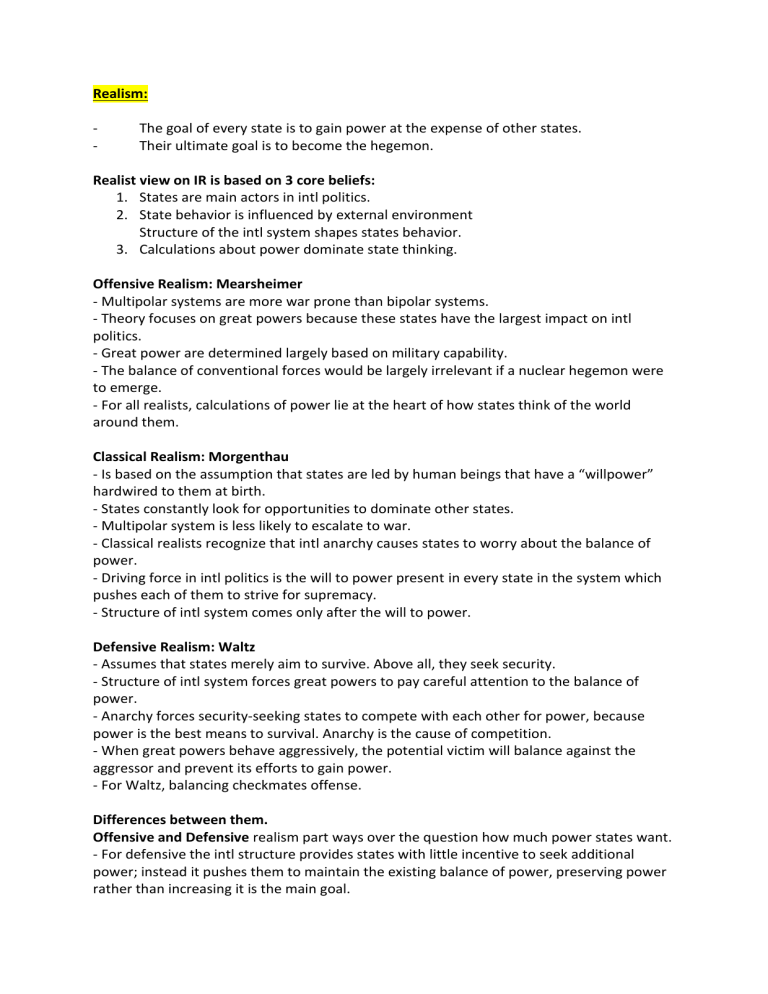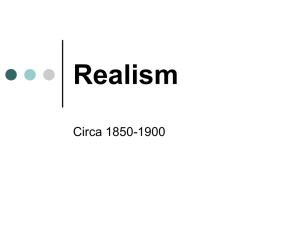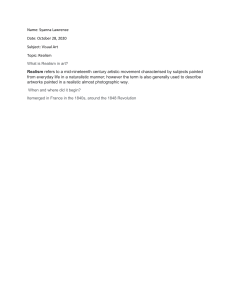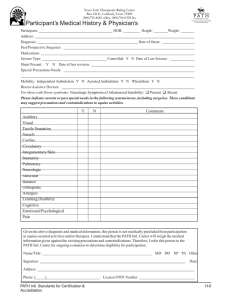
Realism: - The goal of every state is to gain power at the expense of other states. Their ultimate goal is to become the hegemon. Realist view on IR is based on 3 core beliefs: 1. States are main actors in intl politics. 2. State behavior is influenced by external environment Structure of the intl system shapes states behavior. 3. Calculations about power dominate state thinking. Offensive Realism: Mearsheimer - Multipolar systems are more war prone than bipolar systems. - Theory focuses on great powers because these states have the largest impact on intl politics. - Great power are determined largely based on military capability. - The balance of conventional forces would be largely irrelevant if a nuclear hegemon were to emerge. - For all realists, calculations of power lie at the heart of how states think of the world around them. Classical Realism: Morgenthau - Is based on the assumption that states are led by human beings that have a “willpower” hardwired to them at birth. - States constantly look for opportunities to dominate other states. - Multipolar system is less likely to escalate to war. - Classical realists recognize that intl anarchy causes states to worry about the balance of power. - Driving force in intl politics is the will to power present in every state in the system which pushes each of them to strive for supremacy. - Structure of intl system comes only after the will to power. Defensive Realism: Waltz - Assumes that states merely aim to survive. Above all, they seek security. - Structure of intl system forces great powers to pay careful attention to the balance of power. - Anarchy forces security-seeking states to compete with each other for power, because power is the best means to survival. Anarchy is the cause of competition. - When great powers behave aggressively, the potential victim will balance against the aggressor and prevent its efforts to gain power. - For Waltz, balancing checkmates offense. Differences between them. Offensive and Defensive realism part ways over the question how much power states want. - For defensive the intl structure provides states with little incentive to seek additional power; instead it pushes them to maintain the existing balance of power, preserving power rather than increasing it is the main goal. -Offensive realists; believes that status quo powers are rarely found, because the intl system creates powerful incentives for states to gain power at the expense of rivals. A states ultimate goal is to be the hegemon in the system. Offensive and Classical realism portray great powers as relentlessly seeking power. -Key difference is that offensive realists reject Morgenthau’s claim that states are naturally endowed with Type A personalities - Offensive Rationalism = BIPOLAR Classical Rationalism = MULTIPOLAR 10 essential concepts for understanding Realism: 1. Anarchy 6. Hegemony 2. Self-help 7. Polarity 3. Power 8. Balancing 4. Security dilemma 9. Bandwagoning 5. Balance of Power 10. Buck-passing The first Three assumptions of Realism: 1. The intl system is permanently anarchical 2. In anarchy, states cannot assume others will help them survive and they must rely on self-help. 3. Self-help to secure it interests – relatives to others. Multiple States pursuing relative power -> permanent Security Dilemma Realist’s menu of choices for states: Strategies 1. Balancing: states can work to maintain the balance of power. 2. Buck-passing: states can let another state pay the costs of balancing. 3. Bandwagoning: states can join the most powerful states to avoid the costs of balancing them. 4. Hiding: states can try to stay so small, so powerful states will hopefully ignore or forget you. Anarchy: it is an ordering principle, which says that system comprises of independent states that have no CENTRAL AUTHORITY above them. Anarchy -> core concept in the theory of “Political Realism” Realists argue that the intl system is anarchic and this fundamentally determines the character of global politics, historically, today and in the future. Two reasons why intl system is anarchic: 1. No Central Authority There is no authority that establishes rules, laws or provide protection for anyone in the system. 2. No Police Force As a result, there is no mechanism to enforce rules in the system. Consequences of anarchy: 1. Fear – Insecurity Any state bent on survival must be at least suspicious of other states and reluctant to trust them. Additionally, the absence of central authority gives states greater incentive to fear each other. 2. Self-help In an anarchic system, states can only really rely only on themselves for their own security. There are only two ways that states can secure themselves. 1. Increase military power 2. Form alliances 3. Power maximization States pay close attention to how power is distributed among them and make special efforts to maximize their share. States employ a variety of means: economic, diplomatic and military – to shift the balance of power in their favor. -The pursuit of power stops only when hegemony is achieved. The security dilemma: The measures a state takes to increase its own security usually decreases the security of other states. It is difficult for a state to increase its own chances of survival without threatening the survival of other states. The best defense is good offense. : In an attempt to improve their security, in response to lack of authority, states may create unintentional Arms Race. Because no state can be sure of the intention of the other state, and to improve security a state needs to improve their military capability, other states become suspicious and begin to do the same think. As a result, a new environment less secure that the initial one is created due to hostility, suspicion and distrust and could potentially lead nations to war. Balance of Power: - A theory of state behavior, it makes argues about: Why states act the way they do and how they act when they face certain situations. - The whole idea of Balance of Power is a very big part of realism and the realist theory of international relations. Mearsheimer, Waltz: - States act to pressure a balance of power in the system, to prevent any of these states from dominating all the others. i.e. If any of the states are growing its own power to the extent that it can dominate the system, other states will act to balance that power in an effort to achieve an equilibrium in the system. Assume all states are equivalent in power. Balancing can be achieved in one of two different ways: 1. The first way states can balance against the growing power is by: “Increasing their own power:” i.e. state A enhances its power for any political reason, then D grows its power to balance military expand. 2. For any reason, not all states will be able to increase their power: budget constraint! -> so the second way is: “Alliances” i.e. B and C are going to combine their effort to balance the growth of A by forming an alliance. Peace or War: - Preserving the balance of power could mean long period of “peace”. i.e. If the system we have is in equilibrium and stays that way, there might very well be no war in the system. - Sometimes preserving the balance of power requires “WAR”. i.e. Let’s say A decided to attack E for any reason. Then state B, C, D will be worried because if A conquers E it will take all of its resources and add it to its own. Consequently, A’s relative power would increase significantly. In this case, B, C, D are going to prevent this from happening by balancing against A and allying with E. In this case; balance of power actually leads to war, because war becomes necessary to restore or maintain the equilibrium or balance in the system. Dynamic System: - The intl system is very dynamic and the relative power of states within the system is inconstant and changing over the time, so this requires constant adjustments by both states increasing their own power and alliances. Alliances can shift. All of that could be determined by who is considered more threatening to the system. How the systems polarity or distribution of power is maintained. - The whole idea of this realist course is capturing the entire “history” of international relations. The history of the rise and decline of the state power. The history of the rise and decline of the state power. The history of shifting alliances. And the whole idea of all of this is the basic theory that states are engaging in policies to achieve a balance of power or an equilibrium among them in the system to assure that system could not be dominated by a single actor. History: - Balance of power is a theory we can apply today: If we look back in history, many have argued that most of balance of power systems in the world have been multi polar systems. This means that there were multiple centers of power in the system. i.e. Europe prior to WWI and WWII were considered multi polar, because there were many countries five to seven that had the most power in the system. The “great powers”. After World War II: Bi-Polar system. Meaning that there were two centers of power: 1. U.S. and Western allies. 2. Soviet led communist bloc. After the cold war: Unipolar. Meaning that one state was preponderant. The U.S. appeared as a hegemon. : If balance of power theory holds for the future, we should see some states balance against the U.S., balance against this single hegemon and the extent we see that kind of behavior or vice-versa, not seeing it, is a very big part of contemporary debate in world politics.



